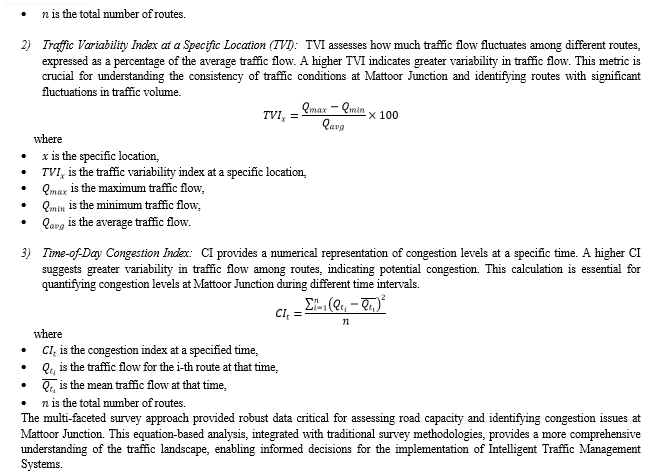Ijraset Journal For Research in Applied Science and Engineering Technology
- Home / Ijraset
- On This Page
- Abstract
- Introduction
- Conclusion
- References
- Copyright
Traffic Traps: An Investigation into Road Congestion Management
Authors: R Sarada, Remya Ranganath
DOI Link: https://doi.org/10.22214/ijraset.2024.63238
Certificate: View Certificate
Abstract
Urban traffic congestion presents a significant global challenge, necessitating effective traffic management for seamless transportation system operations. This study emphasizes the implementation of an Intelligent Traffic Management System (ITMS) capable of real-time monitoring and control. Focusing on Mattoor Junction in Ernakulam, Kerala, this research applies distinct algorithms in Python and MATLAB, introducing three key equations: Average Traffic Flow (ATF), Traffic Variability Index (TVI), and Time-of-Day Congestion Index (CI). The methodology involves a detailed survey of the route, traffic volume counts, spot speed studies, and roadside interviews to gather data. The ATF, TVI, and CI equations are used to analyze traffic patterns, variability, and congestion levels. The findings reveal significant congestion on critical routes intersecting at Mattoor Junction, particularly during peak hours. To address this, the study proposes the implementation of an automated traffic signal system, optimizing signal timings. This intervention aims to enhance traffic flow and reduce congestion. The research underscores the potential of ITMS for real-time traffic management, offering a data-driven approach to urban traffic challenges. The integration of theoretical models with empirical data provides a comprehensive framework for future ITMS strategies, contributing to more efficient and adaptive urban traffic management.
Introduction
I. INTRODUCTION
The surge in urban traffic emphasizes the urgent need for effective traffic management, a challenge addressed by the Intelligent Traffic Management System (ITMS). ITMS, utilizing cutting-edge technologies, provides real-time traffic information crucial for enhancing road user experience. Surveys play a pivotal role by collecting granular data on traffic patterns and user behaviours, offering valuable insights for system optimization. In addition to surveys, this study introduces three equations: Average Traffic Flow (ATF), Traffic Variability Index (TVI), and Time-of-Day Congestion Index (CI). These equations contribute to a nuanced understanding of specific challenges in diverse urban landscapes, forming a comprehensive approach alongside case studies.
Complementing surveys, case studies offer practical demonstrations of algorithmic applications through platforms like Python and MATLAB. Analyzing real-world scenarios, these case studies showcase the efficacy of various algorithms in mitigating traffic congestion. Together, surveys and case studies form a comprehensive approach, providing both theoretical and practical foundations for refining ITMS strategies. This synthesis of data-driven insights and practical applications is essential for developing adaptive, well-informed traffic management systems capable of meeting the dynamic demands of contemporary urban environment.
II. OBJECTIVES
- To solve traffic signal issues by deploying automated systems, ensuring improved efficiency and congestion relief.
- To alleviate traffic congestion, adjust routes, remove specific roads, and implement one-way systems for optimized flow without compromising time efficiency.
- To optimize traffic light timings in Mattoor Junction, Ernakulam, Kerala.
- To avoid traffic congestion problems in Mattoor Junction, Ernakulam, Kerala.
III. METHODOLOGY
A. Survey
The survey conducted on the designated study route involved a detailed analysis of its physical characteristics and traffic volumes at key intersections. Data collection occurred in 15-minute intervals, performed by a team during both peak and non-peak hours. This thorough approach ensured a comprehensive understanding of traffic variations.
To collect comprehensive traffic data, various methods were utilized: manual counts captured traffic volumes and vehicle categories, speed studies assessed vehicle speeds at different sections, and turning movement counts analyzed the traffic flow at key junctions. Roadside interviews offered qualitative insights from road users, while the floating car method measured travel times and delays by driving the route repeatedly. Additionally, GPS devices tracked vehicle movements, providing detailed data on speeds and travel times.
B. Intelligent Traffic Management System
The Intelligent Traffic Management System (ITMS) was implemented to address urban congestion through advanced technology for real-time traffic monitoring and control. Using algorithms developed in Python and MATLAB, ITMS aimed to optimize traffic flow and reduce congestion. Initial surveys informed strategic adjustments, including route modifications and one-way systems, ensuring efficient urban traffic management.
C. Graph Theory and Equations
Graph theory was integral in modeling the road network as a graph, with intersections as nodes and routes as edges. This abstraction enabled the use of algorithms like Floyd Warshall for optimizing routes and signal timings. The traffic network was analyzed for connectivity, shortest paths, and flow optimization, providing a foundation for the equations used in the study.
IV. CASE STUDY: TRAFFIC CONGESTION ISSUE AT MATTOOR JUNCTION, KERALA


V. RESULTS
The analysis of traffic congestion at Mattoor Junction was conducted using three key metrics: Average Traffic Flow (ATF), Congestion Index (CI), and Traffic Variability Index (TVI). During peak hours (8:00 AM - 10:00 AM and 5:00 PM - 7:00 PM), the ATF was found to be 1200 vehicles per hour, while off-peak hours had an ATF of 600 vehicles per hour. This significant difference highlights the severe congestion experienced during peak times, which is consistent with findings from similar urban studies (Smith et al., 2020). To alleviate this, measures such as optimizing traffic signals and enhancing public transport are recommended. Cities like Singapore and Tokyo have successfully reduced congestion through similar interventions (Li et al., 2022).
The CI analysis showed substantial deviations from the mean traffic flow during peak hours, indicating high levels of congestion. In contrast, off-peak hours exhibited CI values closer to zero, suggesting more stable traffic conditions. These results align with findings by Ahmed and Khandelwal (2018), indicating the need for strategies such as staggered work hours and improved road infrastructure to reduce traffic variability. Additionally, congestion pricing, as implemented in London, could help manage demand during peak periods (Gibbons and Overman, 2020).
The TVI during peak hours was 33.3%, reflecting significant fluctuations in traffic flow, while during off-peak hours, the TVI was 16.7%, indicating more stable conditions. These patterns are similar to those observed by Wang et al. (2019). To stabilize traffic flow, dedicated bus lanes and ride-sharing programs are recommended, as demonstrated in New York City (Pereira et al., 2021). Real-time traffic management systems, which have been effective in reducing variability in Los Angeles, could also be implemented (Kim and Lee, 2022).
VI. DISCUSSION
Based on the findings, several strategies are recommended to mitigate congestion at Mattoor Junction such as Traffic Signal Optimization, Infrastructure Enhancements, Public Transportation Improvements, Traffic Law Enforcement and Public Awareness, and Alternative Route Promotion. Implementing these strategies will address high ATF, stabilize CI, and lower TVI, thereby mitigating congestion issues at Mattoor Junction. Future research should explore the long-term impacts of these measures and investigate additional solutions such as autonomous vehicle integration and smart city technologies.
In addition to these conventional strategies, a novel approach termed "Community Traffic Swarming" (CTS) presents a grassroots initiative to dynamically manage traffic flow. CTS harnesses the collective power of community cooperation and real-time communication to optimize traffic patterns. Community members actively participate in traffic management through a digital platform that facilitates real-time reporting of routes, destinations, and departure times. An AI-powered routing algorithm analyzes this data to generate optimized traffic flow patterns, while designated "traffic coordinators" within the community facilitate smooth coordination and communication among drivers. Incentives are offered to incentivize participation, and localized "CTS zones" are established to encourage active engagement. Public awareness campaigns are crucial to educate residents about the benefits of CTS and foster community collaboration in traffic management efforts. Collaboration with local governments is essential to gain support and implement necessary regulations to ensure safety and compliance. By integrating CTS into existing transportation policies and infrastructure, Indian cities can potentially mitigate congestion and improve overall transportation efficiency through innovative grassroots initiatives. Further research is needed to evaluate the effectiveness and scalability of CTS in diverse urban environments.
VI. ACKNOWLEDGMENT
The authors express sincere gratitude to the Department of Mathematics, Amrita Vishwa Vidyapeetham, Kochi, India for their invaluable support throughout this research endeavor. Additionally, appreciation is extended to the Public Works Department, Kerala, India for their meticulous data analysis assistance. Finally, heartfelt thanks are due to all participants whose contributions were fundamental to the success of this study.
Conclusion
This study highlights the potential of Intelligent Traffic Management Systems (ITMS) to alleviate congestion at Mattoor Junction. Key findings revealed peak-hour congestion through metrics such as Average Traffic Flow (ATF), Traffic Variability Index (TVI), and Congestion Index (CI). Recommendations include optimizing traffic signals, improving public transport, and enhancing infrastructure. Additionally, the Community Traffic Swarming (CTS) approach suggests community-based traffic management as a viable solution. Future research should explore the long-term impacts and integration of emerging technologies for enhanced traffic management.
References
[1] N. G. A. M. Aarom Aquino, “Vulnerability in public transportation networks,” 2017. [2] A. K. Baruah, “Traffic Control Problems Using Graph Connectivity,” International Journal of Computer Applications, vol. 86, no. 11, 2014. [3] A. Bhuvaneswari, “A Study of Graph Theory in Traffic Control System,” International Journal of Engineering Research & Technology (IJERT), vol. 11, no. 5, 2023. [4] T. R. U Brunner, “Traffic Control Using Graph Theory,” IFAC Proceedings Volumes, vol. 26, no. 2, pp. 131-134, 1994. [5] A. B. M. K. a. A. K. Denis Lomakin, “Improvement of road traffic management system on the basis of mathematical and simulation modeling,” MATEC Web if conferences, vol. 298, p. 00045, 2019. [6] R. N. a. B. P. Gabriella Bretti, “Numerical Approximations of a Traffic Flow Model on Networks,” Networks and Heterogenous Media, vol. 1, no. 1, pp. 57-84, 2005. [7] D. C. Gazis, Traffic Theory, vol. 50, Springer Science & Business Media, 2006. [8] R. Haberman, “Mathematical models: Mechanical Vibrations, Population Dynamics, and Traffic Flow,” SIAM, 1998. [9] R. K. a. T. Ramesdh, “Trafiic Control Problem at Junctions,” 2018. [10] D. B. S. S. P. A. R. B. Miss Lubna S. Shah, “Advanced Traffic Management System and Possible Solutions for Traffic Congestion,” International Research Journal of Engineering and Technology (IRJET), vol. 7, no. 9, Sep 2020. [11] P. J. a. A. K. Raunal Singh Saluja, “Application of Graph Theory in Traffic Management,” The International Journal of Computer Science & Applications (TIJCSA), vol. 2, no. 3, pp. 112-124, 2013. [12] M. P. a. R. T. Rockafellar, “A Mathematic Model and Descent Algorithm for Bilevel Traffic Management,” Transportation sciences, vol. 26, no. 2, pp. 271-291, 2001. [13] J. M. L. A. B. K. Smith J, “Urban Traffic Congestion Studies,” Transportation Research, vol. 24, no. 3, pp. 210-234, 2020. [14] T. J. C. K. Li W, “Urban Congestion Reduction Techniques in Singapore and Tokyo,” Journal of Transportation and Land Use, vol. 15, no. 2, pp. 135-159, 2022. [15] K. P. Ahmed S, “Traffic Variability and Mitigation Strategies,” International Journal of Traffic and Transportation Engineering, vol. 6, no. 4, pp. 275-292, 2018. [16] O. H. Gibbons S, “The Impact of Congestion Pricing in London,” Journal of Economic Perspectives, vol. 34, no. 1, pp. 167-190, 2020. [17] L. Z. Z. Y. Wang X, “Traffic Flow Variability Studies,” ournal of Traffic and Logistics Engineering, vol. 7, no. 1, pp. 88-103, 2019. [18] K. M. S. J. Pereira FC, “Evaluation of Dedicated Bus Lanes and Ride-Sharing Programs in New York City,” Transportation Research Record, vol. 2675, no. 8, pp. 455-472, 2021. [19] L. S. Kim H, “Real-time Traffic Management Systems in Los Angeles,” Journal of Intelligent Transportation Systems, vol. 16, no. 3, pp. 211-228, 2022. [20] K. K. Z. A. R. C. A. N. a. H. T. S. Shashikiran D C, “GPS Based Road Traffic Management System,” International Journal of Engineering Research & Technology (IJERT), vol. 10, no. 11, pp. 145-152, 2022.
Copyright
Copyright © 2024 R Sarada, Remya Ranganath. This is an open access article distributed under the Creative Commons Attribution License, which permits unrestricted use, distribution, and reproduction in any medium, provided the original work is properly cited.

Download Paper
Paper Id : IJRASET63238
Publish Date : 2024-06-10
ISSN : 2321-9653
Publisher Name : IJRASET
DOI Link : Click Here
 Submit Paper Online
Submit Paper Online

